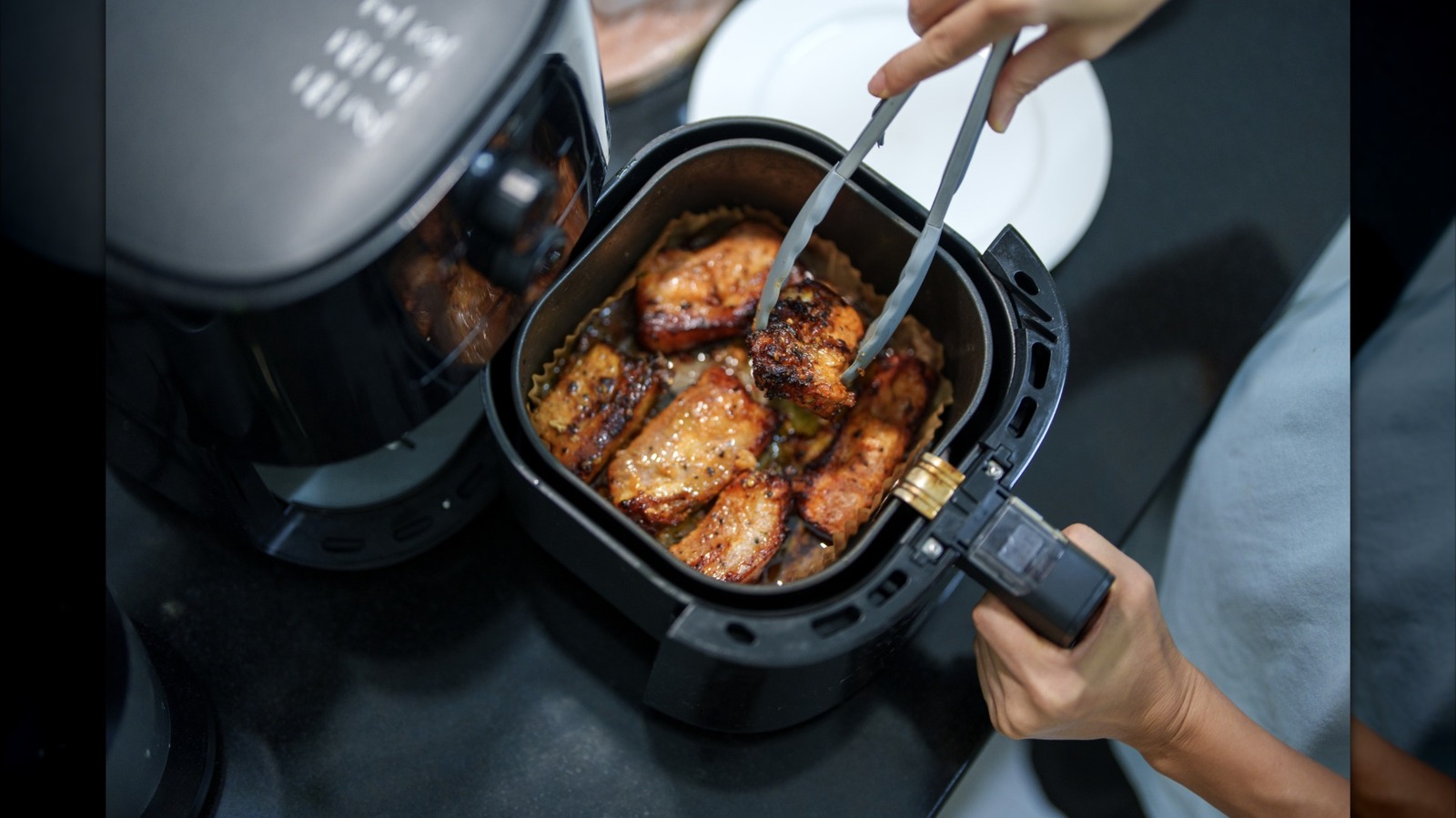We may receive a commission on purchases made from links.
The air fryer as a modern kitchen appliance has become a favorite of home cooks and a popular purchase due to its compact nature, ease of operation, and versatility. However, similar to an oven or microwave, an air fryer, if not taken care of properly, can suffer consistent wear and tear over the course of its lifetime. The ingredients used, cleaning methods implemented, and placement of your air fryer can dictate its performance in the long run, and poor use or maintenance can turn into frustration when your air fryer stops operating effectively. There are many common mistakes air fryer experts continue to see people making when using this appliance in their homes. To help you preserve your air fryer, here are the 10 most common mistakes people make that damage their models, according to experts, as well as their tips, tricks, and recommendations to get the most out of this handy kitchen appliance.
Don’t overcrowd the basket
One of the most common mistakes amongst air fryer users is to overcrowd the cooking basket with food. Jam-packing the basket with ingredients means they often end up overlapping, which can lead to your food “steaming” but not gaining a crispy exterior due to a lack of air exposure. However, overcrowding the basket doesn’t only affect the quality of the food you’re air frying, but according to bestselling cookbook author and air fryer specialist Clare Andrews, “overcrowding the air fryer basket is a common mistake that people make; this can lead to poor air circulation which in turn leads to uneven cooking and strains the fan and heating element as it must work harder.”
While there’s no “one size fits all” approach to spacing food in an air fryer, the general rule of thumb is to have a single layer of food with a bit of space between each item. Of course, this doesn’t mean you need to spend time spacing out every single fry you put in the basket! Just check there isn’t any food resting on top of each other in the cooking basket, this results in your air fryer effectively circulating heat, leading to even cooking, crispier food, and faster cooking times. If you’re preparing large quantities of food, cook in batches to ensure you can maintain this spacing and minimize any unnecessary strain on your air fryer unit.
Clean your air fryer regularly (and properly)
Cleaning is a key aspect of maintaining the condition of any kitchen appliance, but air fryers require specific cleaning processes, methods, and tools to protect them from wear and tear. Clare Andrews sees a lack of regular cleaning as the primary culprit for many common issues encountered by owners of air fryers. “Skipping regular cleaning is a mistake, as the grease and crumbs can block airflow, which can affect heating or even cause smoke or odors,” Andrews says. “I would recommend cleaning the basket, trays and drawer after each use and wipe the heating element weekly.”
While you may be regularly cleaning your air fryer, you might still be making a mistake with how you are doing it. First of all, you should always make sure to hand-wash components like the cooking basket and shell. Even if your air fryer manufacturer specifies that a component is “dishwasher safe,” air fryer users consistently suggest it’s still worth going the extra mile of hand washing to prevent unnecessary damage. From a safety perspective, make sure you never submerge the main air fryer unit in water. If you need to clean the unit or heating element, always make sure you have unplugged the unit and allowed it to cool fully.
Use appropriate accessories and tools
The tools, equipment, and cooking utensils you use to operate or clean your air fryer can significantly impact its lifespan. Jenny Tschiesche, nutritionist, well-being expert, and author of the bestselling Air-Fryer Cookbook, shared that her biggest air fryer ‘don’t’ is “Using the wrong equipment to move or remove food,” as “Using metal implements will damage the nonstick lining of your air fryer.” Instead, Tschiesche recommends air fryer owners use non-metal utensils, such as ones made with silicone or food-grade plastic. Kitchen utensils made with materials are a great alternative that will also protect your air fryer from unnecessary scratching or peeling.
When it comes to cleaning your air fryer cooking basket, use non-abrasive cloths, sponges, and brushes to remove food stains and residue while protecting its nonstick coating. Purchasing a scrubbing brush with softer bristles ensures you do not strip away the interior of your cooking basket or air fryer, and there are plenty of scrub brushes available in stores that offer this gentle touch. Even better, Tschiesche says, “Using a soft brush can be helpful for getting into nooks and crannies,” meaning you can get rid of all those hard-to-reach buildups of food residue, oil, and grease.
Make sure to follow air-fryer best practices
without losing too much moisture or crispiness, but remember that more delicate ingredients requiring a shorter cooking time or lower temperature may actually benefit from an air fryer that has not been preheated.
Clare Andrews pointed out that air fryers are not designed to handle cooking certain foods, especially ones coated in wet batters such as beer-batter or tempura. “This can be a problem as the liquid batter tends to drip through the basket, causing a mess in the bottom tray and potentially splashing onto the heating element,” Andrews says. Other best practices for cooking with an air fryer include ensuring your food is portioned evenly and any baking paper you use is weighted down to prevent it from being blown up into the heating element (a potential fire hazard).
Pay special attention to the heating element
Nestled safely above the cooking basket, the heating element is the component of your air fryer responsible for generating the heat which is circulated throughout the cooking basket. Requiring special attention and care, heating elements are prone to buildups of grease and oil when not cleaned regularly, and for Clare Andrews, paying attention to the heating element is crucial for protecting your air fryer and helping it perform at the highest level. Andrews says, “A huge do for me is clean the air fryer thoroughly and regularly, including the heating element. A clean air fryer also cooks more evenly and efficiently!”
To clean your heating element properly, start by unplugging the unit and letting it cool down (if used recently). Then, Jenny Tschiesche recommends taking a damp cloth and gently wiping away any food stains, grease, or oil covering the heating element. While you should use a warm, damp cloth, take care not to leave any excessive moisture remaining in the heating coil, as this can cause your air fryer to smoke when next used. To minimize moisture buildup, make sure you wipe down the heating element after cleaning with a dry, non-abrasive cloth, and then leave the cooking basket out of the air fryer temporarily to help the heating element dry completely. Regularly cleaning the heating element can breathe life into your air fryer and help it perform at its full potential.
Rotate food during the cooking process
Rotating or flipping food during the cooking process is a standard practice to assist your air fryer with evenly cooking food. Clare Andrews sees this as a good idea for all users, regardless of how powerful or advanced an air fryer they are working with. “I would suggest rotating or shaking the food for even cooking; even with a powerful fan, air doesn’t always circulate perfectly,” Andrews says. “Shake or flip food halfway through cooking to avoid undercooked patches or over-crisped edges.”
Rotating food in the cooking basket as opposed to just “shaking” means your ingredients will be cooked, caramelized, and crispy on all sides. For most dishes and ingredients, one rotation mid-way through the cooking process will be sufficient. For larger air fryer recipes or portions of food, multiple turns of the ingredients may be necessary, but be cautious not to open your air fryer too often throughout the cooking process as this can disrupt and strain the heating element. It’s also worth mentioning that rotating food during the cooking process minimizes the risk of food residue sticking to or burning in the cooking basket, both of which can reduce the lifespan of your unit by damaging its interior.
Ensure proper ventilation and safe air-fryer placement
An often neglected trick to easily help your air fryer last a lifetime is to place it in a well-ventilated space on a stable, level surface. As an air fryer produces a significant amount of heat that is released from the unit during operation, it should never placed in an enclosed space or next to flammable materials. As Clare Andrews says, “Another mistake that people often make is placing their air fryer too close to a wall or under a wall unit as the external heat generated by air fryer during cooking needs space to escape.”
Posing a significant fire hazard, air fryers should, at a minimum, have several inches of clearance around the unit to ensure it can effectively release heat. However, most ideally, you should place your air fryer on an open kitchen countertop to give it the best chance to steadily release heat. As ventilation is essential for reducing any stress placed on your air fryer’s heating element, an open countertop is not only the safest placement for your model but also ideal for both its performance and longevity.
Use the right amount (and type) of oil
The air fryer, unlike many other kitchen appliances and cookware, does not operate effectively with large amounts of liquid. When it comes to oil, you shouldn’t be adding enough as you would for shallow or deep-frying cooking methods, but a small amount can help you achieve that crispiness and flavor you’re hungry for. When it comes to the best way to use oil in your air fryer, both Clare Andrews and Jenny Tschiesche recommend using aerosol-based sprays with emulsifiers. “I would avoid using aerosol cooking sprays directly on the air fryer basket as these sprays contain propellants that break down non-stick coatings over time, causing peeling and making the basket harder to clean,” Andrews says.
To help you steer clear of aerosol-based sprays, Andrews recommends you purchase a refillable spray bottle, which you can instead fill with olive oil. This air fryer hack allows you to spray a light amount of oil onto your food without any risk of adding too much to the cooking basket, causing smoking or grease buildup. If you would prefer to not purchase a spray bottle, Andrews also suggested that you brush your food with a thin coating of olive oil after placing it in the cooking basket, and you should always choose cooking oils with a high smoke point as these are suitable for higher cooking temperatures.
Avoid using harsh chemicals for cleaning
Cleaning products can contain a range of chemicals that will deteriorate and eat away at your air fryer’s interior. Generally, it is recommended that you avoid using harsh chemicals when cleaning your unit, with air fryer manufacturers suggesting soaking your air fryer components in regular dish soap and warm water. When paired with using softer cleaning brushes and sponges, warm, soapy water should be enough to help you break down and wipe away the most common food stains and residue.
For tougher buildups of grease and hard-to-remove stains, do not jump to pouring chemical cleaners such as bleach, oven cleaners, or degreasers into your air fryer. Chemical cleaners such as these can peel away the non-stick interior of your air fryer unit, but if you really need a more powerful way to remove stains without damaging the basket and surfaces, you can try mixing baking soda and water to create a paste for scrubbing away and breaking down food residue.
Follow manufacturer guidelines specific to your model
Depending on the specific model or brand of your air fryer, there may be other key guidelines or instructions you should consider implementing. As air fryers continue to evolve and newer models are being released, it is becoming increasingly important to refer to your manufacturer’s instructions to confirm whether you are properly caring for your unit. According to Jenny Tschiesche, “Most air fryers are made using a nonstick coating. Increasingly brands are using ceramic nonstick coating. Ceramic is easier to damage so it’s important that you use the right implements internally and that you care for your air fryer basket according to manufacturer’s instructions.”
Similar to the previous mistakes in this list, failing to follow your air fryer manufacturers instructions, guidelines, and/or recommendations can significantly shorten the lifespan of your specific model. Really, it’s worth checking any available information as it can help you get the most out of your air fryer and teach you about any unique functions or features you may be unaware of. It will also help you to protect your unit for years to come and continue to produce wonderful air fryer meals and delights.





